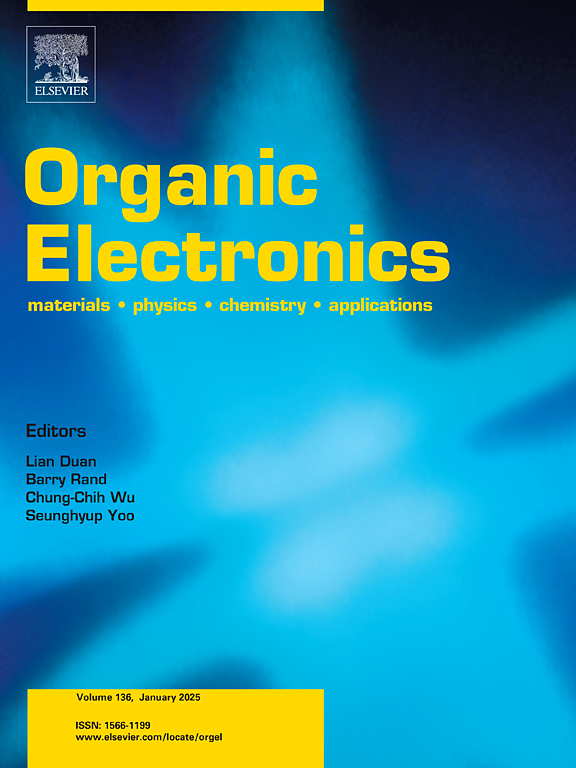通过晶粒控制和缺陷缓解优化钙钛矿发光二极管的性能和耐久性
IF 2.6
4区 工程技术
Q3 MATERIALS SCIENCE, MULTIDISCIPLINARY
引用次数: 0
摘要
准二维钙钛矿发光二极管(PeLEDs)的最新进展由于其吸引人的特性,包括易于溶液加工,可调谐的发射光谱和成本效益而引起了极大的关注。然而,阻碍其性能的一个关键挑战仍然是钙钛矿发射层的质量。针孔和卤化物空位等形态和结构缺陷会严重阻碍随后的层沉积,导致漏电流通路的形成。此外,这些晶格缺陷通常作为非辐射复合中心,影响器件的整体发光效率。本研究提出了一种简单的策略,通过在钙钛矿前驱体溶液中加入聚乙烯氧化物(PEO)和三甲基丙烷三丙烯酸酯(TMPTA)作为添加剂来解决这些限制。PEO的高粘度有效地限制了钙钛矿前驱体的扩散,导致形成更小更均匀的晶粒。此外,TMPTA中的C=O官能团与钙钛矿中的非配位Pb2+阳离子相互作用良好,从而抑制非辐射重组过程。通过精心优化PEO和TMPTA添加剂的体积比,实现了钙钛矿薄膜缺陷的有效钝化和晶粒形貌的控制,从而显著提高了钙钛矿发射层的质量。因此,绿色发光二极管的最大电流效率和外量子效率分别达到45.3 cd/A和12.01%。本工作建立了一种简单有效的方法来制造高效、稳定的等离子体发光二极管。本文章由计算机程序翻译,如有差异,请以英文原文为准。

Optimizing performance and durability of perovskite light-emitting diodes through crystal grain manipulation and defect mitigation
Recent advancements in quasi-two-dimensional perovskite light-emitting diodes (PeLEDs) have garnered significant attention due to their attractive properties, including facile solution processability, tunable emission spectra, and cost effectiveness. However, a critical challenge hindering their performance remains the quality of the perovskite emitting layer. Morphological and structural imperfections such as pinholes and halide vacancies, can significantly impede the subsequent layer deposition, leading to the formation of leakage current pathways. Furthermore, these lattice defects often serve as non-radiative recombination centers, compromising the device's overall luminescence efficiency. This study presents a facile strategy to address these limitations by incorporating polyethylene oxide (PEO) and trimethylolpropane triacrylate (TMPTA) as additives within the perovskite precursor solution. The high viscosity of PEO effectively restricts the diffusion of perovskite precursor, leading to the formation of smaller and more uniform crystal grains. In addition, the C=O functional group in TMPTA interacts favorably with uncoordinated Pb2+ cations in perovskite, thereby suppressing non-radiative recombination processes. By meticulously optimizing the volume ratio of PEO and TMPTA additives, effective passivation of perovskite film defects and manipulation of crystal grain morphology are achieved, leading to a significant enhancement of the perovskite emitting layer quality. Consequently, the maximum current efficiency and external quantum efficiency of green light-emitting diodes reach 45.3 cd/A and 12.01 %, respectively. This work establishes a simple and effective methodology for fabricating efficient and stable PeLEDs.
求助全文
通过发布文献求助,成功后即可免费获取论文全文。
去求助
来源期刊

Organic Electronics
工程技术-材料科学:综合
CiteScore
6.60
自引率
6.20%
发文量
238
审稿时长
44 days
期刊介绍:
Organic Electronics is a journal whose primary interdisciplinary focus is on materials and phenomena related to organic devices such as light emitting diodes, thin film transistors, photovoltaic cells, sensors, memories, etc.
Papers suitable for publication in this journal cover such topics as photoconductive and electronic properties of organic materials, thin film structures and characterization in the context of organic devices, charge and exciton transport, organic electronic and optoelectronic devices.
 求助内容:
求助内容: 应助结果提醒方式:
应助结果提醒方式:


